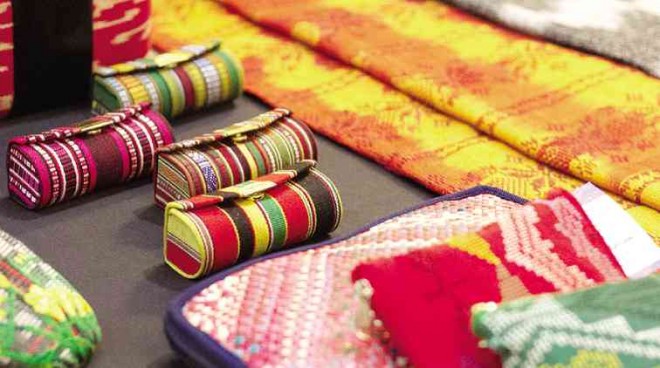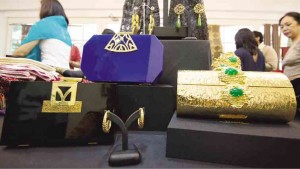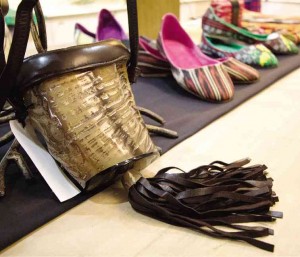

Centuries-old Filipino weaving traditions are in peril of being overwhelmed by consumerism and low-cost mass-produced textiles.
But an exhibit seems to give indigenous textiles a lifeline and a fighting chance by stoking demand for them.
And to generate a demand, indigenous textiles and ancient weaving traditions must remain relevant. That means, among others, updating the design sensibilities of local artisans so that their products can become wearable, everyday clothes.
“The Bukidnon costumes from Manila Collectible are now worn by teenagers as blouses over shorts or skirts. [They’ve] become very fashionable,” says Monserrat Guingona-David, president of Habi: The Philippine Textile Council.

Witness how far traditional looming has gone in the 4th Likhang Habi Bazaar on Oct. 24-26 at the Glorietta Activity Center in Ayala Center, Makati City.
Habi envisions a strong textile culture that will become part modern living. It seeks to do this by preserving, promoting and enhancing Philippine textiles through education, communication and research.
Fabrics woven by artisans in indigenous communities speak of the Philippines’ cultural narrative, said Maria Isabel Ongpin, chair of Habi. To preserve weaving traditions is therefore to safeguard the country’s history and heritage.
This cultural narrative is rendered in modern pieces during the Likhang Habi Bazaar.
There will be home accessories such as lampshades, baskets, mats, blankets, tablecloths and runners, placemats, napkins, and bedcovers.
Contemporary interpretations by young designers of the fabrics will also be showcased. RTW barong, for example, will be in traditional textiles such as hablon, t’nalak, piña-silk, piña-cotton, and abaca.
Also to be exhibited are shoes in t’nalak cloth, as well as scarves and wraps, and beaded and woven clutches.
“Traditions are endangered because the young generation is no longer interested in working with their hands,” says Ongpin. “They find (traditional crafts) tedious. Life is so fast now. But from what I saw in Aklan, if there’s a market people will fill the vacuum. Even young boys are weaving in Aklan. Every piña is being bought.”
Piña as heritage
Ongpin is pushing for the piña, a fabric extracted by hand from the long leaves of Spanish red pineapple, to rise to the level of Indonesia’s batik. In 2009, Unesco recognized the batik an Intangible Cultural Heritage.
“Piña fabric is just as much identified with our country, our people, our environment, our traditions and our history as batik is to Indonesia,” Ongpin explains. “China is trying to produce piña with machines but it is only in the Philippines where we do it by hands from planting to harvesting to producing the finished goods.”
Ongpin says the Philippine weaving industry is struggling to survive. Natural calamities such as typhoons has even affected the sourcing of raw materials because of the damage to agriculture of disasters.
Moreover, artisans need design education to fuse contemporary and traditional designs. Local weaving communities in addition don’t know how to market their products.
And this is where Habi enters the picture.
David says there’s a need to provide design education to young weavers.
David says Habi was gratified to learn that hablon-weaving has become part of the high curriculum in Iloilo.
In Lake Sebu, South Cotabato, Habi is training the local community in weaving inside a longhouse it donated.
Pet peeve
Emi Daniel, GM of Nooks Manufacturing Int’l Corp., one of the bazaar exhibitors, said there are a few surviving cotton farms in Ilocos, but no factory is spinning it. Nooks says it managed to spin a few tons into piña-cotton to create fashionable bags.
Daniel says her pet peeve is Filipinos’ assumption that just because a product is locally made it should be cheap, that is, dirt-cheap.
Her handmade bags, she says, take an average of two days to make and are properly done, she says, “no short cuts,” and cost just P2,400. Compared to mass-produced international brand names that carry a high price tag, she say Nooks bags are cheap but provide higher quality.
The bazaar will highlight an updated look of the banig, the traditional woven mat from Samar and Bukidnon, in different patterns and shapes, organizers aid.
Also featured are inabel from La Union; Cordillera weaves from Banaue and Benguet; t’nalak from Cotabato; piña from Aklan and Palawan; hablon and patadyong from Iloilo; Mangyan textiles and baskets from Mindoro; and Yakan weaves from Basilan.
Starting out with just 20 exhibitors four years ago, Likhang Habi Market Fair now has around 50.
“And the product keeps getting better and better. That’s what competition does,” Ongpin says.

